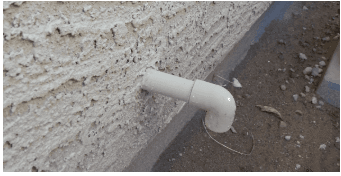If you notice a large amount of water pooling up around your indoor AC unit, you could have a clogged AC drain line.
If you wish to try and clear the clog yourself, you can do so at the outside drain line. Don’t worry, we’ll walk you through the process.
If you’re going the DIY route, you’ll need a few things, such as:
- A wet/dry vacuum
- A wire brush
- Duct tape
Note: If the clog can't be cleared strictly from the outside drain line, you’ll need to contact a professional to have a closer look at your system and clear the clog for you.
Don’t have the time or materials to DIY? No problem! Give us a shout and we’ll be happy to help!
Step #1: Go to your AC drain line (outside)
Every AC system has a condensate drain line (a white PVC pipe) that runs from your indoor air handler to the outside of your home. During normal operation, condensate is safely carried out of your home via the drain line. You’ll usually find the drain line near the outdoor condenser unit.

An example of the drain line outside your home.
Step #2: Clear the clog with the wet/dry vacuum
Once you’ve located the drain line outside, you can use the wire brush to clear or loosen the clog, if you think it’s closer to the end of the drain line. But, if no debris or water comes through, it means the clog is higher up in the line.
If this is the case, you can try using the wet/dry vacuum to clear the clog.
Just follow these steps:
- Attach the vacuum hose to the end of the drain line.
- Wrap the duct tape around the end of the vacuum hose and the drain line to ensure the connection is secure and airtight.
- Turn the vacuum ON and let it run for a few minutes.
After a few minutes, the vacuum should suck out any debris or obstructions that may be clogging the line. If the process worked, you’ll see algae (or brown gunk) collected inside the vacuum.
However, if the vacuum doesn’t suck out any debris, the clog is probably even higher up in the condensate line. If so, you’ll need a professional to unclog it for you.
Reminder: Be sure to contact a professional if you’re unable to clear the clog yourself strictly from the outside drain line.
Still having issues after trying the DIY tips above?
It’s time to call a professional. As we mentioned, if the clog can’t be cleared using the suggested equipment from the outside drain line, it’s a sign that the clog is higher in the line. Clogs that are high up in the condensate drain line need to be cleared at the indoor air handler inside your home.
Clearing the clog at your indoor unit is a job that should only be left to a professional. Why? For starters, trying to access a unit that’s in a hard-to-reach area of your home (like the attic), can be very dangerous if you don’t know what you’re doing.
Also, your indoor air handler can be a very tricky and delicate component to work with. By attempting to tinker with the unit yourself, you risk creating more water damage and potentially hurting the AC unit/system as a whole.
With a trained technician, you can rest assured that your system is in good hands and the clog will be cleared using the best (and safest) methods available.
Looking for a Texas pro to unclog your AC drain line? We’re here to help!
Everything is bigger in Texas, but our team has never come across a problem too big to handle. We’ll unclog your AC drain line and have your system running smoothly again in no time.
You can also inquire about adding a float switch for your system (if you don’t have one already), which automatically turns off your system if water is backing up due to a clog.
